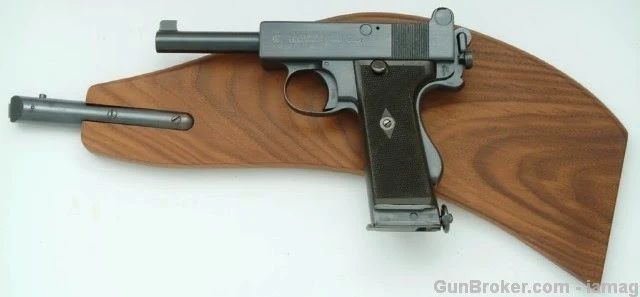Also of potential interest to the reader are a series of photographs depicting the variants of the weapon, and a comprehensive table of the quantity and respective serial numbers of both the government contracts and private sales by month and year of production.
So with full acknowledgment and expressed gratitude to both The American Rifleman, and its parent organization, The National Rifle Association, please enjoy the following definitive article. Please double click on any of the images to enlarge them.
The following photograph is of Royal Navy Officers, probably circa 1914 or later, using a dangerous combination of weapons: Webley & Scott self-loading pistols and Webley revolvers. The mighty 265 grain bullet fired by the automatics was propelled by a fast burning 7.0 grains of Revolver Cordite. This cartridge could be chambered in the .455 cal. revolver. If loaded and fired by mistake, it would blow the wall of the revolver's cylinder out.
Although the cap badges clearly connote commissioned officers, the reefer or "monkey" jackets without any rank lacing are somewhat of a mystery. Perhaps some form of working dress? Readers have responded with one plausible explanation. Individuals shown are Warrant Officers with less than ten years in rank, thus no lace, but still should have three gilt buttons, per uniform regulations in effect at the time. Perhaps all are Warrant Armourers familiarizing themselves with the then new weapon. Also note the absence of any pistol cases (holsters) and belts either web or leather.
A packet of seven cartridges as issued for the Webley self-loading pistol. Particularly note the warning, "NOT FOR REVOLVERS".
After about three decades consider myself very fortunate to have acquired an original wrapped package of seven rounds of ammunition shown above. But miracle of miracles, was more recently (May 2016) able to find an original correct magazine for the pistol (in remarkably excellent condition), in of all places Warsaw, Poland. Owners of the pistol will readily appreciate and attest to the fact that a single magazine is significantly harder to find than specimens of the pistol itself. Note the small stamped "2" on the base of the magazine, and the two magazine catch position notches allowing the weapon to be hand loaded and fired with single cartridges while maintaining 7 rounds in the offset loaded magazine. This is believed to be a unique design feature of the weapon.
In addition to the procurement of the pistols for the Royal Navy and Marines, records show there were 100 pistols issued to the Royal Horse Artillery in 1913 (some also to the fledgling Royal Flying Corps in April 1915). 50 of these were fitted with shoulder stocks. They were also fitted with an adjustable rear sight and a safety catch which could be rotated between the hammer and the back of the receiver. These weapons were designated, the .455 Mk. I No. 2. As expected this model is even rarer due to the limited number produced. Recently one of these guns was at auction for a reserve price of $12,500.00 USD, complete with shoulder stock. However it has been completely re-blued, albeit (allegedly) to original specification. With acknowledgment and full credit to the seller and GunBroker.com, the reader can view the pistol in this configuration.
For those possibly interested in additional information on the Webley Model 1912/1913 Pistol please see; https://www.youtube.com/watch?v=A8j3VIILQjI .





















No comments:
Post a Comment